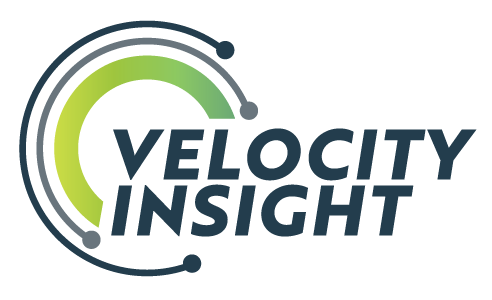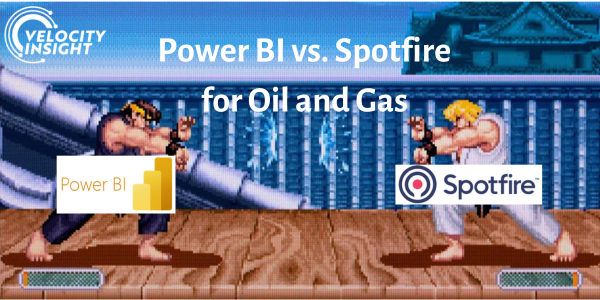As a data analytics nerd in O&G, a very common question I get is
“Which do you like better, Power BI or Spotfire?”
This is a lot like asking me which of my kids I like more: I love them both equally and I couldn’t imagine life without them. But they each drive me crazy sometimes.
So let’s stack them up head-to-head: Power BI vs. Spotfire!
We’re going to cover four big areas of differences between the two most important Business Intelligence (BI) tools for oil & gas companies. Note that both Power BI and Spotfire have active development, so this view is based on a snapshot in time as of late 2023:
- Routine report distribution
- Mapping and regressions
- Sources and integrations
- Cost
As an aside, there are lots of other, subtler differences that are crucial for specific workflows. I’m focused on these as the most important issues for a typical E&P company that wants to use a BI tool for data discovery, analysis, and reporting. Your mileage may vary!
Routine report distribution
We think Power BI wins here. When used by someone who knows what they’re doing, both tools have good ability to distribute the kind of reports you probably want – Lease Operating Statements, Production Surveillance reports, and such. But Microsoft has the advantage of the larger Office 365 infrastructure to make that distribution easier and more featureful.
E&P’s using Power BI almost always use the Azure Power BI Service for publishing, which provides a simple web interface so that report authors can set up data refresh and scheduled emails. The Power BI smartphone apps just work out of the box, leveraging the same infrastructure as other Microsoft apps like Outlook, OneNote, and Teams aps. One complexity is the Power BI Gateway, which is required so that on-prem data sources can move through the firewall in a secure way. It’s a simple process, but unfamiliar to first-time Power BI authors – call us if you need help with it.
Spotfire-focused E&P’s are much more likely to use on-prem Spotfire Servers implementations managed by IT departments. These require a lot of work to get implemented properly, with version/user management and Automation Services setup being time-consuming and error-prone. We see that as being a non-issue for large, mature Spotfire shops, but smaller and newer companies have often struggled to get these working properly.
The ease of use is what really drives the differences here. We find that setup is much easier for business users to handle on Power BI – daily refreshes, email distributions, and smartphone access. We’d love to see Spotfire re-imagine that infrastructure, but it hasn’t been a focus area in their last few releases.
One final issue is how long it takes to open a report. Since Power BI Service reports are always stored in-memory on the Azure Service, they generally pull up within seconds. We’ve often seen Spotfire reports that take 10 minutes or longer to open as the data has to be paged into memory. There are ways to prevent that, but too many Spotfire tools are too slow to open.
Mapping and regressions
We think Spotfire wins here. Spotfire’s dominance in the E&P vertical in the early 2010’s gave it a chance to develop some really nice functionality for O&G-friendly maps and the kind of regressions that petroleum engineers and geologists love. Power BI simply hasn’t focused on those areas much, although that seems to be changing.
Spotfire’s sales and dev teams heard a clear message when they started out – mapping is really important to O&G customers, and shapefiles are our preferred format for geospatial data. The typical map of a land grid, translucent acreage layers (in yellow of course!) and horizontal well sticks is very easy to make in Spotfire, with clean interactivity between maps and other visuals. Similarly, Spotfire has very easy-to-use linear regression lines available to help quantify and visualize trends, even in noisy data.
On the other hand, because Power BI’s target market is and always was “everyone”, Microsoft has never invested in spatial visualizations to the same degree. You can’t simply import a shapefile, to the immense frustration of O&G people (you have to use GeoJSON). Microsoft’s strategy instead has instead been a partnership with ESRI for the “ArcGIS for Power BI” visual. That visual has some really nice capabilities, but you’ll have added cost and expertise required to make that work.
Finally, Power BI’s out-of-the-box regression capabilities are quite limited – much less capable than Excel, in fact. Power BI’s focus has always been on “presentation-ready” visuals (fonts, colors, tilting, etc.) while Spotfire seems to focus more on engineering-oriented visualizations (box-whisker plots, lasso select, details on demand, etc.)
Sources and Integrations
We think Power BI wins here. Microsoft is doing the thing it has done over and over again – use its huge ecosystem and market power for business software to make a New Thing the default choice. Note that this has sometimes gotten them into trouble before!
For E&P companies, we think the Teams and PowerPoint integrations are big deals. Almost all E&P companies we know use Teams at some level – much of that adoption happened during COVID, and it has stuck around. Being able to embed dashboards into Teams channels (and have chats about them) is great for collaboration. The PowerPoint integration is appealing for those routine deck-building functions like Finance and Accounting, although it mostly makes sense when you have a pretty robust company-wide implementation with everyone having access to Power BI.
Spotfire’s independence is a blessing and a curse here. Spotfire’s owner (the blandly named Cloud Software Group) simply has no way to drive the kinds of tight integration with Office products in the way that Microsoft can. On the other hand, the fact that they are neutral between the AWS, Azure, and GCP gives them a bit more breadth than Power BI. We love that breadth, but Microsoft’s incumbent position with Office and Active Directory makes a tight Microsoft integration more valuable to most E&Ps. That said, if your company has made a strategic choice to host data and applications on AWS, the flexibility to host Spotfire on AWS as well is probably appealing.
Cost
We think Power BI wins here, but both tools are really good values. Compared to the cost of most E&P software tools, BI tools are really, really cheap.
Power BI’s pricing is pretty transparent – $10/user/month for either authoring or viewing reports on the web and smartphone app. It could be basically free if you’re using E5 licenses, or if you’re a larger company, enterprise license at $5k/month. Power BI Desktop (the authoring tool) is completely free if you don’t care about sharing reports.
Spotfire used to show pricing on their website, but alongside some of their recent organizational changes as they separated from TIBCO, that’s no longer the case. Anecdotally, Spotfire Analyst licenses cost about $100/mo, while Spotfire Consumer licenses cost about $50/mo. If you’re looking at 1000 licenses, that does add up.
Big picture, the licensing costs of BI tools are tiny compared to the cost of properly implementing them. We’re big believers that Construction should usually be outsourced, but Upkeep should be done in-house. No matter how you go about it, building good data pipelines and actionable visualizations take real investment, so don’t get too hung up in the license fees.
Wrap-up
Like I said at the top, we at Velocity Insight love both tools. I’ve been using Spotfire since 2010 and Power BI since 2019, and there are use cases where each really shine. The data we have from our E&P Software Survey indicates E&P’s feel the same way: a huge number of companies end up choosing both. A few factors you should be considering:
- Do you need to use your BI tool to distribute reports?
- Are your data sources cloud-hosted? If so, which cloud platform are they on?
- What are your needs for mapping? Do you have a robust ArcGIS implementation, or are you working with scattered shapefiles?
- Are you already deep into the Microsoft world with E5 licenses and heavy Teams usage?
- What does your team know how to use today, and what are you willing to invest to teach them new skills?
We hope this has been useful – we love talking about this stuff, so reach out if you want to know more!


